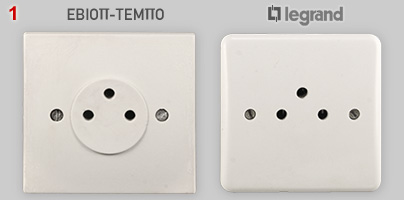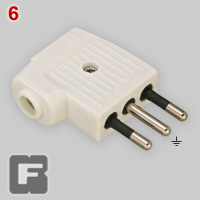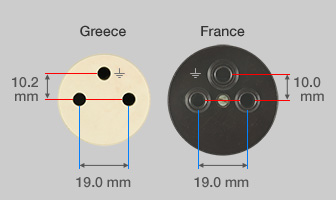 |
Domestic earthed sockets and
plugs formerly used in Greece |
 |
Domestic earthed sockets and
plugs formerly used in Greece |
| Domestic earthed sockets and plugs were
mid 20th century introduced in Greece by regionally operating Greek
and foreign electricity companies. Earthed sockets, found in the
Thessaly region (and possibly elsewhere) had three contacts,
either in a triangle configuration (probably French design) or three in
a row (Italian type). In 1989, Greek authorities have decided to switch to the CEE 7/3-7/4 (Schuko) standard for earthed plugs and sockets. Occasionally old type sockets can still be found in Greek homes. Adapters are available to connect modern appliances. Background information given by Michail
Kritsotakis, who also has donated
the sockets shown in image no. 1.
In formal Greek language socket is revmatodotis (current giver), but better known in ordinary Greek as priza or mpriza. Plug is revmatoliptis (current taker), or fis, but more commonly used is visma. Words (m)priza and fis are derived from the French words prise (socket) and fiche (plug). The word tripoliki means three-poles, the trhee contacts / pins of earthed devices (not to be confused with with the Peleponnese city Tripoli), hence the addition of mpreza / visma. |
 |
 |
 |
 |
 |
| 1 | Domestic
sockets with contacts positioned in a triangle, rated at 6A - 250V.
Dimensions of contacts are given in a table below. Manufacturer of socket left: Eviop-Tempo*; right: Legrand (Limoges, France) socket, part of 'Neptune' series. {MKG} Line and neutral contacts are not specified, and orientation of sockets (earth top or down) is questionable. Dating: probably 1970s. The Greek companies Eviop and Tempo merged in 1965. The Legrand socket has a logo that was introduced in 1975. Both sockets have been found in the same house in Leontari (Thessaly region). The Legrand socket is very similar to an old, now obsolete, French type socket. See comparison of both sockets for details. * electrical equipment manufacturer based in Visiliko, Greece (see website). For Legrand, see manufacturers info. |
| 2 | Tripoliki 6A - 250V plugs
that match with sockets shown in image no. 1. Left: Greek plug made by a yet unknown manufacturer, using a logo with characters tau and phi. {KVW} Middle: French plug made by Legrand. The round Legrand logo is an uncommon type; not shown on the Legrand website. Right: Greek connector plug made by the company using the tau-phi logo. {SZ} |
| 3 | Multi-plug for three tripoliki plugs. The multi-plug has additional holes halfway between the power contacts. Therefore, Italian 10A 3-pin plugs (see no. 6) can be inserted also, but the additional holes have no earth contact. No manufacturer logo {SZ} |
| 4 |
Adapter plug, rated at 10-16A - 250V with
tripoliki pins and Schuko (Σούκο) outlet. Manufacturer of a adapter nos 4 and 5: yet unknown company using a logo with two characters rho. {SZ} |
| 5 | Schuko adapter plug with outlet that
accepts both tripoliki and Italian 10A plugs. The lower hole is used
only to keep parts of the adapter together. {SZ} |
 |
 |
 |
 |
| 6 |
10A
plug that comply with Italian standard
CEI 23-50. Fits in socket
no. 9. The plug has a CEE (European Conformity) mark. Manufacturer:
Ningbo Kaifeng Electric Appliance, Cixi City, Zhejiang, China. Images 6 - 8 show material used in the coastal port city Volos (Thessaly). {SZ} |
| 7 | Italian CEI 23-50 type 10A connector plug,
made by Greek company using tau-phi logo. {SZ} |
| 8 | 10A-16A adapter plug with Italian type pins and Schuko outlet, made by company using rho-rho logo {SZ} |
| 9 | 1960s Bticino 10A CEI 23-50 socket and (separate) switch. Photo has been taken by Yvonne Goester in a home in Volos. |
| Comparison
of tripoliki and obsolete
French socket Greek tripoliki sockets are nearly identical to a (now obsolete) earthed socket that was used in France prior to the introduction in 1956 of sockets with an earth pin (Norme Franšaise C15-100). The Bakelite socket left has been made by Legrand, in the late 1930s - early 1950s. Tripoliki plugs and "old French" plugs (see Legrand example in image no. 2) fit perfectly in both sockets. For plug compatitbility the small difference in offset of socket earth contact is negligible. |
 |
|
Feature
|
(Greece) |
(France) |
|
Indicated
rate of socket (250 Volt)
|
|
|
|
Diameter
of socket surface contact gap of resp. L, N / earth
|
4.9 / 5.1 mm | 5.2 mm |
|
Offset
of
socket earth contacts
|
10.2 mm | 10.0 mm |
|
Diameter
of
pins
|
4.0 mm | 4.0 mm |
|
Length
of pins (and earth pin, if different from L and
N)
|
|
|
| The striking similarity between tripoliki and
old French plugs and
sockets must have a reason. It is a tempting hypothesis that they have
been
introduced in Greece during electrification work by French
companies. Note that the Greek words mpreza (socket) and fis
(plug) are
derived
French words prise and fiche. |
In 1956 earth pin sockets became the official standard in France. Greece could have been an attractive market for the inevitable declining French market for 3-pin plugs and matching sockets. |
 If
you recognize a logo, please send me a
mail;
find my address at the home page. |
Logos of
manufacturers of yet unknown Greek companies. Left: logo with Greek characters tau and phi, found on plugs 2 and 7. Right logo with two characters rho, found on adapters 4, 5 and 8. Both Greek socket no. 1 and Tau-Phi plug no. 2 carry the abbreviation E.Y.B., which may stand for Εθνικό Υπουργείο Βιομηχανίας (National Ministry of Industry) that could have been responsible for certifications (from 1988 issued by ΕΛΟΤ / ELOT). |
| |
Digital Museum of | |
Plugs and Sockets | |